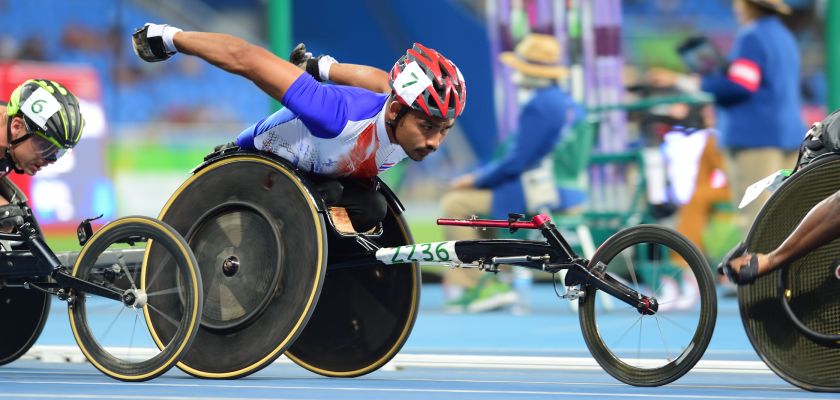What do you know about Paralympic athletics? Synonymous with overcoming, the sport carries impressive life stories and promotes reflections on inclusion, diversity and valuing abilities. That’s why we’ve put together everything about Paralympic athletics.
In this article, you’ll learn about the history of paralympic athletics, understand once and for all how it works and even meet the main athletes!
Participate in our free WhatsApp community and receive daily tips, news and trivia from over 50 sports! Click here to join.
Everything about Paralympic athletics: what it is
Paralympic athletics is a sport adapted for athletes with physical, visual or intellectual disabilities, and represents an important part of the Paralympic Games, an international sporting competition aimed at athletes with disabilities, governed by the International Paralympic Committee (IPC).
The rules and adaptations of Paralympic athletics vary according to the type of disability of the athletes, but the aim is to provide a level playing field for competitors and promote inclusion in sport. It is one of the most popular disciplines.
Everything about Paralympic athletics: history
The first sports initiatives for people with disabilities began to emerge at the beginning of the 20th century, especially after the First World War, which left many soldiers wounded and with physical disabilities.
The Stoke Mandeville Games, held for the first time in 1948, were an important milestone in the history of paralympic athletics. These games were organized by neurologist Sir Ludwig Guttmann as a form of rehabilitation for war veterans with spinal cord injuries. It was the forerunner of the modern Paralympic Games.
First Paralympic Games
The first Paralympic Games took place in Rome, Italy, in 1960, as a parallel event to the Olympic Games. Around 400 athletes from 23 countries took part, competing in sports such as athletics, swimming, table tennis and wheelchair basketball.

Nas décadas seguintes, os Jogos Paralímpicos se tornaram cada vez mais populares, e passaram a contar com um número maior de países participantes. O atletismo paralímpico acompanhou essa popularidade.
Entre 1990 e 2000, o atletismo paralímpico passou por um processo de profissionalização, com a introdução de regras mais rigorosas, avanços tecnológicos e um aumento na visibilidade e no reconhecimento internacional.
Paralympic athletics today
The Sydney 2000 Paralympic Games were an important milestone, with record attendance and unprecedented television coverage.
In recent years, Paralympic athletics has continued to evolve, with the development of new categories and adaptations for athletes with different types of disabilities, as well as greater integration with conventional athletics in events such as world championships and international competitions.
Today, Paralympic athletics provides opportunities for athletes with disabilities to showcase their skills and overcome challenges in high-level global competition.
Who can take part in paralympic athletics?
According to the Brazilian Paralympic Committee, Paralympic athletics can be practiced by athletes with physical, visual or intellectual disabilities.
It is also divided into running, jumping, throwing and throwing events for both men and women.
Paralympic athletics classes
Paralympic athletics classes are organized according to the type of disability. The athlete’s classification is defined by a letter and a number: T (“track”) for track events and F (“field”) for field events. The numbers represent disabilities.
Visual impairment
- T11: Athletes with total absence of vision or very limited vision.
- T12: Partially sighted athletes with the ability to perceive shapes at close range or with peripheral vision.
Physical Disability
- T31 to T34: Athletes with cerebral palsy who compete in running and javelin throwing events.
- T35 to T38: Athletes with cerebral palsy or other disabilities who compete in running, jumping and throwing events.
- T51 to T54: Physically disabled athletes competing in wheelchair racing events.
- F40 to F46: Athletes with amputations or other disabilities who compete in running, jumping and throwing events.
Intellectual Disability
- T20: Athletes with intellectual disabilities who compete in running, jumping and throwing events.
You can check out more information in the Brazilian Paralympic Committee’s explanatory video:
Everything about Paralympic athletics: top athletes
Check out some of the world’s leading paralympic athletes:
- Marieke Vervoort (Belgium): wheelchair racer, won gold and silver medals at the Paralympic Games.
- David Weir (United Kingdom): wheelchair racer, multiple gold medalist at the Paralympic Games and world championships.
- Marcel Hug (Switzerland): known as “The Silver Bullet”, he is a wheelchair racer who has won several medals at the Paralympic Games and world championships.
- Omara Durand (Cuba): a blind runner, she is one of the fastest athletes in the world in her category, winning multiple gold medals at the Paralympic Games and world championships.
- Richard Whitehead (United Kingdom): a runner with bilateral amputation, he has won gold medals at the Paralympic Games and holds world records in various distances.
- Hannah Cockroft (United Kingdom): a wheelchair racer, she is one of the most dominant athletes in her category, winning multiple gold medals at the Paralympic Games and world championships.
- Daniel Dias (Brazil): physically disabled swimmer, he holds a large number of Paralympic medals and is considered one of the greatest Paralympic swimmers of all time.
- Sophie Hahn (United Kingdom): a runner with cerebral palsy, she has won several gold medals at the Paralympic Games and world championships, setting world records in her category.
- Liu Wenjun (China): a visually impaired runner, he is one of the fastest athletes in his category, winning multiple gold medals at the Paralympic Games and world championships.
- Aled Davies (United Kingdom): a disabled discus thrower and weight thrower who has won several gold medals at the Paralympic Games and world championships, setting world records in both disciplines.
These athletes represent just a small sample of the talent and determination present in the sport. And now that you know everything about paralympic athletics, how about following our content to find out about other sports?





